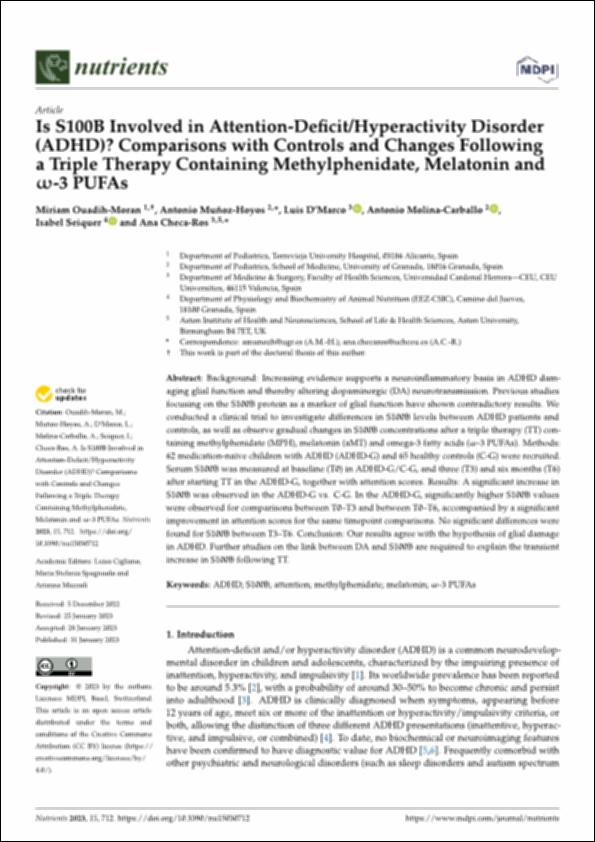Por favor, use este identificador para citar o enlazar este ítem:
http://hdl.handle.net/10637/16167Is S100B involved in Attention-Deficit/Hyperactivity Disorder (ADHD)?: comparisons with controls and changes following a triple therapy containing Methylphenidate, Melatonin and ω-3 PUFAs
| Título : | Is S100B involved in Attention-Deficit/Hyperactivity Disorder (ADHD)?: comparisons with controls and changes following a triple therapy containing Methylphenidate, Melatonin and ω-3 PUFAs |
| Autor : | Ouadih Morán, Miriam Muñoz Hoyos, Antonio D'Marco Gascón, Luis Gerardo Molina Carballo, Antonio Seiquer, Isabel Checa Ros, Ana |
| Materias: | Tratamiento médico; Medical treatment; Trastorno por Déficit de Atención con Hiperactividad (TDAH); Attention Deficit Hyperactivity Disorder (ADHD); Metilfenidato; Methylphenidate; Melatonina; Melatonin |
| Editorial : | MDPI |
| Citación : | Ouadih-Moran, M., Muñoz-Hoyos, A., D'Marco, L., Molina-Carballo, A., Seiquer, I. & Checa-Ros, A. (2023). Is S100B involved in Attention-Deficit/Hyperactivity Disorder (ADHD)?: comparisons with controls and changes following a triple therapy containing Methylphenidate, Melatonin and ω-3 PUFAs. Nutrients, vol. 15, i. 3, art. 712 (31 jan.). DOI: https://doi.org/10.3390/nu15030712 |
| Resumen : | Background: Increasing evidence supports a neuroinflammatory basis in ADHD damaging glial function and thereby altering dopaminergic (DA) neurotransmission. Previous studies focusing on the S100B protein as a marker of glial function have shown contradictory results. We conducted a clinical trial to investigate differences in S100B levels between ADHD patients and controls, as well as observe gradual changes in S100B concentrations after a triple therapy (TT) containing methylphenidate (MPH), melatonin (aMT) and omega-3 fatty acids (ω-3 PUFAs). Methods: 62 medication-naïve children with ADHD (ADHD-G) and 65 healthy controls (C-G) were recruited. Serum S100B was measured at baseline (T0) in ADHD-G/C-G, and three (T3) and six months (T6) after starting TT in the ADHD-G, together with attention scores. Results: A significant increase in S100B was observed in the ADHD-G vs. C-G. In the ADHD-G, significantly higher S100B values were observed for comparisons between T0–T3 and between T0–T6, accompanied by a significant improvement in attention scores for the same timepoint comparisons. No significant differences were found for S100B between T3–T6. Conclusion: Our results agree with the hypothesis of glial damage in ADHD. Further studies on the link between DA and S100B are required to explain the transient increase in S100B following TT. |
| Descripción : | Este artículo pertenece al número especial "The Impact of Nutrition on Brain Metabolism and Disease". |
| URI : | http://hdl.handle.net/10637/16167 |
| Derechos: | http://creativecommons.org/licenses/by/4.0/deed.es Open Access |
| ISSN : | 2072-6643 (Electrónico) |
| Fecha de publicación : | 31-ene-2023 |
| Centro : | Universidad Cardenal Herrera-CEU |
| Aparece en las colecciones: | Dpto. Medicina y Cirugía |
Los ítems de DSpace están protegidos por copyright, con todos los derechos reservados, a menos que se indique lo contrario.


